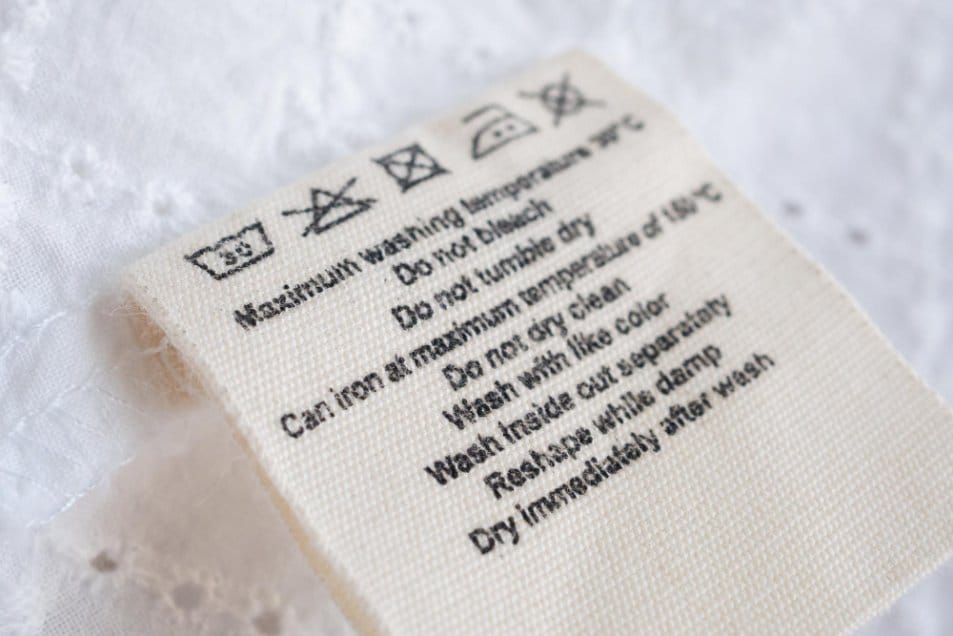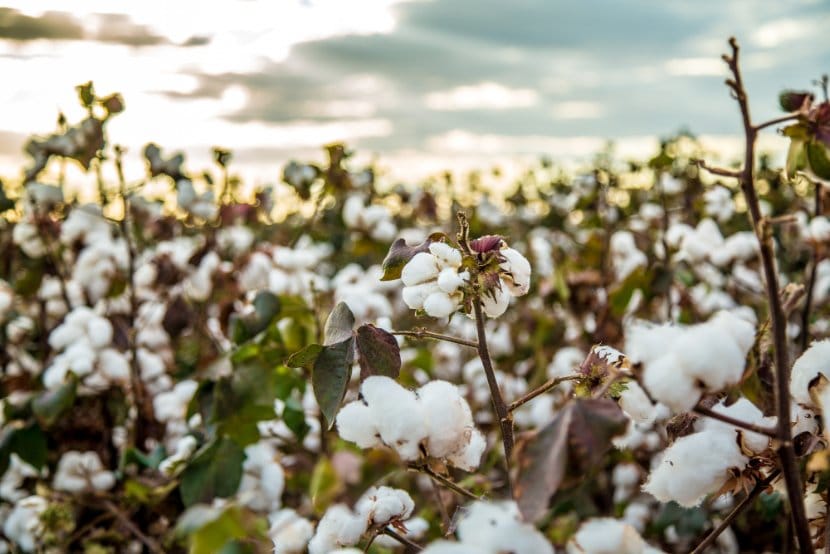Everything you need to know about choosing, using, and caring for cotton jersey fabric
If you’ve ever worn a comfortable t-shirt or a soft dress that moves with you, chances are it was made from cotton jersey. This fabric has become a wardrobe staple because it combines comfort, breathability, and stretch in a way few other materials can match.
In this guide, you’ll learn what makes cotton jersey special, how to choose the right weight for your projects, and how to care for it properly. Whether you’re a home sewer planning your next project or simply curious about the fabric in your closet, this article will give you all the information you need.
Table of Contents
- What is Cotton Jersey Fabric?
- History and Why It’s Called “Jersey”
- Types of Cotton Jersey
- Understanding Fabric Weight (GSM)
- Feel, Stretch, and Performance
- Cotton Jersey Blends
- How Cotton Jersey is Made
- Cotton Jersey vs Other Fabrics
- Summer or Winter Fabric?
- How to Identify Cotton Jersey
- What You Can Make
- Care and Washing Instructions
- Understanding and Preventing Shrinkage
- Pros and Cons
- Buying Guide and Quality Indicators
- Frequently Asked Questions
- Conclusion
What is Cotton Jersey Fabric?
Cotton jersey is a knitted fabric made from cotton fibers. Unlike woven fabrics such as cotton poplin or canvas, cotton jersey is created by looping yarns together in a specific pattern. This knitting method gives the fabric natural stretch and a soft drape.
When you look at cotton jersey, you’ll notice it has two different sides. One side is smooth, while the other shows visible loops. This is the signature look of single jersey, the most common type you’ll find.
What is the Difference Between 100% Cotton and 100% Cotton Jersey?
Both contain the same cotton fibers, but the difference is in construction:
- 100% Cotton: This is a general term that includes any fabric made entirely from cotton. It could be woven (like broadcloth) or knitted (like jersey).
- 100% Cotton Jersey: This specifically means cotton that has been knitted, not woven. The knitting process creates stretch and softness.
Think of it this way: all cotton jersey is 100% cotton (if it contains no other fibers), but not all 100% cotton is jersey. A crisp button-up shirt and a soft t-shirt can both be 100% cotton, but they feel completely different because one is woven and one is knitted.
Is Jersey Cotton 100% Cotton?
It depends. Pure cotton jersey contains 100% cotton fibers. However, many manufacturers add small amounts of synthetic fibers like spandex or lycra (typically 5-10%) to improve stretch and help the fabric return to its original shape. Always check the label to see the exact fiber content.
History and Why It’s Called “Jersey”
Where Does Cotton Jersey Originate From?
The name “jersey” comes from the Island of Jersey, located in the English Channel between England and France. During the Middle Ages, fishermen on this island created a special knitting technique to make warm, flexible sweaters from wool. These garments needed to stretch for physical labor while keeping them warm in harsh sea conditions.
The knitting method spread throughout Europe over time. As textile manufacturing evolved, producers began using the same technique with cotton fibers instead of wool. By the 20th century, cotton jersey had become incredibly popular for everyday clothing like underwear, t-shirts, and casual wear.
Why are They Called Jersey?
The word “jersey” originally described any garment made using this specific knitting technique from Jersey Island. Over time, people started using “jersey” to refer to the fabric itself rather than just the finished clothing. Today, when someone says “jersey fabric,” they mean the knit construction method, not the island where it originated.
One interesting note: athletic jerseys (sports uniforms) got their name because they were traditionally made from this type of knitted fabric, though modern sports jerseys often use synthetic materials instead.
Types of Cotton Jersey
Cotton jersey comes in two main construction types, and understanding the difference helps you choose the right one for your project.
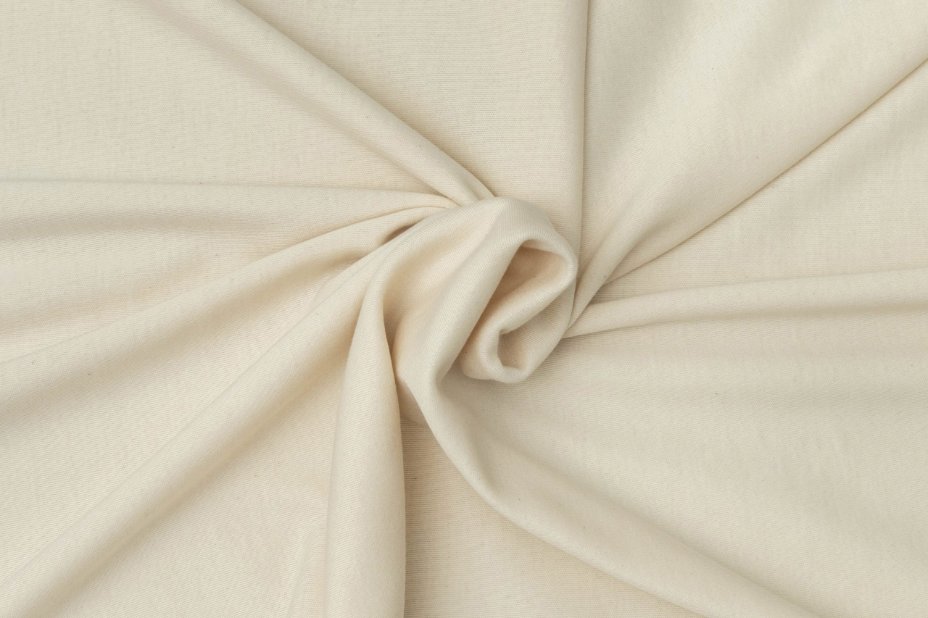
Single Jersey
Single jersey is made with one set of knitting needles. This creates a fabric with two distinct sides:
- Front side: Smooth and flat
- Back side: Textured with visible loops
Single jersey has good horizontal stretch and a lightweight feel. The edges tend to curl toward the smooth side when you cut them, which is completely normal. This is the fabric you’ll find in most t-shirts.
Double Jersey (Interlock)
Double jersey, also called interlock, uses two sets of knitting needles working at the same time. This creates a thicker fabric that’s smooth on both sides. The edges don’t curl like single jersey, making it easier to work with for some projects.
Double jersey feels more substantial and structured. You’ll often find it in polo shirts, sweatshirts, and heavier garments.
Comparison: Single Jersey vs Double Jersey
| Feature | Single Jersey | Double Jersey (Interlock) |
|---|---|---|
| Needles Used | One set | Two sets |
| Texture | Smooth front, looped back | Smooth on both sides |
| Typical Weight | 150-220 GSM | 220-280 GSM |
| Stretch | Excellent horizontal stretch | Moderate stretch, more stable |
| Edge Behavior | Curls when cut | Stays flat |
| Feel | Lightweight, airy | Thicker, warmer |
| Best For | T-shirts, summer dresses, tops | Hoodies, winter wear, structured garments |
Understanding Fabric Weight (GSM)
GSM stands for “grams per square meter.” This number tells you how heavy the fabric is, which affects how it looks, feels, and performs. Understanding GSM helps you choose the right cotton jersey for your needs.
What are the Different Weights of Cotton Jersey?
| Category | GSM Range | Feel | Best Uses |
|---|---|---|---|
| Lightweight | 150-180 | Very soft, fluid, may show through slightly | Summer t-shirts, baby clothes, lightweight dresses, pajamas |
| Medium-Light | 180-200 | Soft with good flow, not see-through | Standard t-shirts, tops, kids clothing |
| Medium | 200-220 | Balanced weight, structured, fully opaque | Dresses, casual tops, leggings, everyday wear |
| Medium-Heavy | 220-250 | Substantial, holds shape well | Hoodies, sweatshirts, activewear, winter dresses |
| Heavyweight | 250+ | Thick, sturdy, excellent coverage | Heavy sweatshirts, winter garments, outer layers |
What is Heavy Cotton Jersey?
Heavy cotton jersey weighs 250 GSM or more. This weight provides excellent warmth, durability, and structure. It maintains its shape better than lighter weights and offers complete coverage without any transparency. Heavy cotton jersey works great for cooler weather and garments that need to hold their form.
Is Jersey Fabric Thick or Thin?
It can be either, depending on the GSM. Lightweight jersey (150-180 GSM) is quite thin and perfect for hot weather. Heavyweight jersey (250+ GSM) is substantially thicker and better for cold weather. Most everyday t-shirts fall in the medium range (180-220 GSM).
Feel, Stretch, and Performance
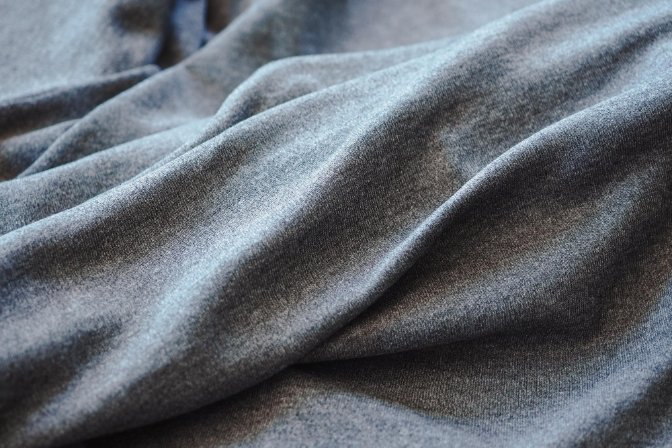
What Does Jersey Knit Cotton Feel Like?
Cotton jersey has a distinctly soft, smooth texture that many people describe as “buttery” or like a second skin. When you run your hand over it, the smooth side feels sleek and gentle. The fabric drapes beautifully and flows naturally rather than standing stiffly like woven cotton fabrics.
The knit structure makes cotton jersey conform to your body shape without feeling tight. When you stretch it, you’ll feel it give easily and then bounce back to its original form.
Is Cotton Jersey Stretchy?
Yes, cotton jersey stretches naturally because of how it’s knitted. Most cotton jersey has what’s called “2-way stretch,” which means it stretches side to side but not up and down. Here’s what you can typically expect:
- Horizontal stretch: 25-50% (depending on the knit quality and fiber content)
- Vertical stretch: Minimal in pure cotton jersey, more in blends with spandex
To test stretch yourself, fold a 10cm section of fabric and gently pull. For every extra centimeter past 10cm, that’s 10% stretch. So if it stretches to 15cm total, you have 50% stretch.
Is Cotton Jersey Fabric Breathable?
Absolutely. Cotton jersey is highly breathable for two reasons:
- Natural cotton fibers: Cotton naturally allows air to pass through
- Knit structure: The loops in the knit create tiny gaps that increase airflow
Scientific testing shows cotton jersey has impressive performance metrics. Research from Textile Exchange demonstrates that quality cotton jersey maintains an air permeability rate of approximately 1.6 dm³/s and water vapor resistance of just 2.9 m² Pa/W. In everyday language, this means air moves through easily and sweat evaporates quickly, keeping you comfortable.
Does Jersey Fabric Keep You Cool?
Yes, cotton jersey works well for staying cool because it’s breathable and wicks moisture away from your skin. When you sweat, the cotton absorbs it and allows it to evaporate quickly, which creates a cooling effect. This is why cotton jersey is so popular for summer clothing.
Is Cotton Jersey Healthy?
Cotton jersey offers several health benefits, especially for people with sensitive skin:
- Hypoallergenic: Natural cotton rarely causes allergic reactions
- Chemical-free option: Organic cotton jersey contains no pesticides
- Breathable: Reduces skin irritation by allowing air circulation
- Moisture-wicking: Keeps skin dry, which reduces bacterial growth
- Soft texture: Won’t scratch or irritate sensitive areas
Is Cotton Jersey Good for Eczema?
Yes, cotton jersey is an excellent choice if you have eczema or other sensitive skin conditions. The soft texture won’t irritate inflamed skin, and the breathability helps prevent heat and moisture buildup that can trigger flare-ups. For best results, choose 100% organic cotton jersey and wash it with fragrance-free, gentle detergents.
Is Jersey Material Flattering?
Cotton jersey can be very flattering when you choose the right weight and fit. The fabric’s natural drape creates a flowing silhouette that skims your body without clinging excessively. For the most flattering results:
- Choose medium-weight jersey (180-220 GSM) for structure without stiffness
- Look for cotton-spandex blends (95/5) for better shape retention
- Consider darker colors to minimize any transparency
- Make sure garments fit properly, as jersey will show lines
Cotton Jersey Blends
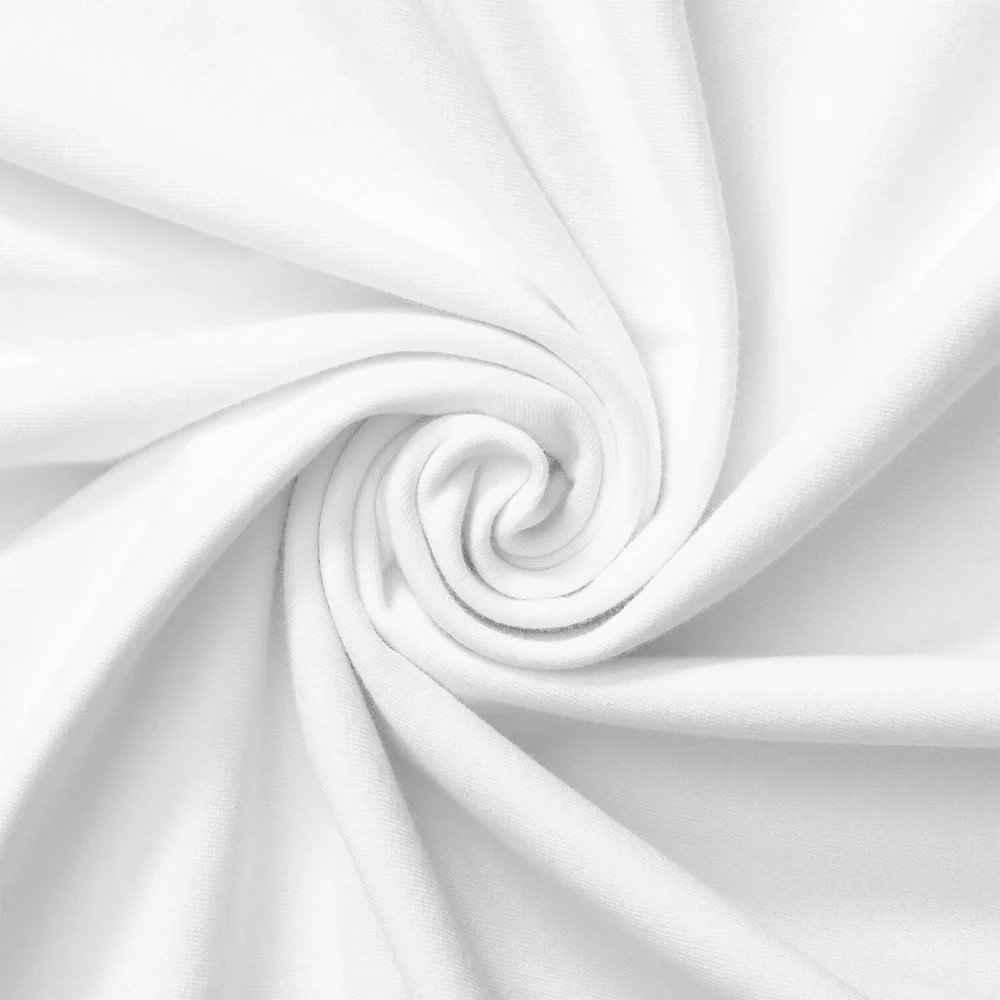
Is Cotton Jersey the Same as Cotton Lycra?
No, they’re different but related. “Cotton jersey” refers to the knitting method, while “cotton lycra” (or cotton spandex) describes the fiber content. Here’s how they differ:
- 100% Cotton Jersey: Pure cotton fibers knitted into jersey fabric with natural stretch
- Cotton Lycra Jersey: Cotton jersey with added spandex/lycra fibers for extra stretch
You can have 100% cotton jersey (no synthetics) or cotton lycra jersey (cotton plus stretch fibers). Both use the jersey knitting method.
Can You Get 100% Cotton Jersey?
Yes, 100% cotton jersey is widely available. Many manufacturers produce pure cotton jersey with no synthetic blends. These fabrics offer maximum breathability and natural comfort. The trade-off is they may have slightly less stretch recovery compared to cotton-spandex blends, meaning they might stretch out a bit with wear.
Is Cotton Jersey Synthetic?
Pure cotton jersey is not synthetic because it’s made from natural cotton plant fibers. However, many commercial cotton jersey fabrics include small amounts of synthetic fibers (like 5-10% spandex or polyester) to improve performance. Always check the label to see if your cotton jersey is 100% natural or a blend.
Common Cotton Jersey Blends
| Blend Type | Common Ratio | What It Does | Best For |
|---|---|---|---|
| Cotton-Spandex | 95/5 or 90/10 | Adds stretch, helps fabric bounce back, maintains shape | Fitted clothing, activewear, leggings, bodycon dresses |
| Cotton-Polyester | 60/40 or 50/50 | Increases durability, resists wrinkles, dries faster | Performance wear, athletic clothing, work uniforms |
| Cotton-Bamboo | 70/30 or 60/40 | Extra softness, antibacterial properties, eco-friendly, silky feel | Luxury basics, sensitive skin clothing, sleepwear |
| Cotton-Modal | 55/45 | Silky texture, beautiful drape, breathable, less shrinkage | Dresses, flowy tops, premium t-shirts |
How Cotton Jersey is Made
Understanding how cotton jersey is manufactured helps you appreciate the quality and choose better fabric. For more background on cotton production, check out this detailed guide about cotton. According to the National Cotton Council, modern cotton production involves sophisticated processes from field to fabric.
The Manufacturing Process
Cotton bolls are harvested from cotton plants and processed to remove seeds and debris.
Cotton fibers are cleaned, carded (combed to align fibers), and any short strands are removed to create quality yarn.
Processed fibers are spun into yarn using either ring-spinning (creates smoother, stronger yarn) or rotor-spinning (faster, more economical) methods.
Yarn is loaded into circular knitting machines that loop the yarn continuously to create the interlocking structure. Single jersey uses one set of needles, while double jersey uses two.
The fabric is washed, often pre-shrunk, dyed to the desired color, and treated for specific characteristics like softness or wrinkle resistance.
Ring-Spun vs Rotor-Spun Cotton
Ring-spun cotton goes through a process where the fibers are twisted and thinned, creating finer, softer, and more durable yarn. This produces premium cotton jersey with excellent feel and longevity. According to Sewport’s comprehensive fabric directory, ring-spun cotton creates smoother, more refined textiles. It costs more but lasts longer.
Rotor-spun cotton uses a faster, less expensive spinning method. It still produces good fabric, but the texture is slightly coarser and less refined than ring-spun cotton.
Cotton Jersey vs Other Fabrics
How Does Cotton Jersey Compare to Other Knits?
| Fabric Type | Construction | Stretch | Weight | Best For |
|---|---|---|---|---|
| Cotton Jersey | Single knit, interlocking loops | Good horizontal stretch (25-50%) | Light to medium | T-shirts, everyday clothing, dresses |
| French Terry | Looped pile on inside | Moderate stretch | Medium to heavy | Sweatshirts, loungewear, athletic wear |
| Rib Knit | Vertical ridges both sides | Excellent stretch and recovery | Medium | Cuffs, neckbands, fitted clothing |
| Interlock | Double knit, smooth both sides | Moderate, more stable | Medium to heavy | Polo shirts, structured garments |
| Ponte Knit | Double knit, tight structure | Minimal stretch | Heavy, structured | Pants, jackets, professional wear |
Which is Better, Cotton or Cotton Jersey?
This comparison doesn’t quite work because cotton jersey IS cotton. The real question is whether you want woven cotton or knitted cotton (jersey). Here’s how to decide:
Woven Cotton
Examples: Poplin, twill, canvas
- Little to no stretch
- Crisp and structured
- Holds shape very well
- Better for tailored garments
- More formal appearance
- Durable and long-lasting
Cotton Jersey (Knitted)
Examples: T-shirt fabric, jersey dresses
- Natural stretch built-in
- Soft and comfortable
- Flows and drapes beautifully
- Better for casual, fitted clothing
- More relaxed look
- Comfortable for all-day wear
Choose woven cotton when you want: Button-up shirts, dress pants, structured skirts, formal wear
Choose cotton jersey when you want: T-shirts, casual dresses, comfortable tops, activewear
Is Cotton Jersey for Summer or Winter?
Is Cotton Jersey Material for Summer or Winter?
The answer is both, depending on the weight you choose. Cotton jersey adapts to different seasons based on its GSM rating.
Summer Cotton Jersey
- Weight: 150-200 GSM
- Lightweight and airy
- Maximum breathability
- Quick-drying in heat
- Perfect for t-shirts and summer dresses
- Keeps you cool and comfortable
Winter Cotton Jersey
- Weight: 250+ GSM
- Thicker, warmer fabric
- Often double jersey (interlock)
- Provides insulation
- Great for hoodies and sweatshirts
- Works well as a layering piece
Is Cotton Jersey Good for Summer?
Yes, lightweight cotton jersey (150-200 GSM) is excellent for summer. It combines all the qualities you need for hot weather:
- Highly breathable, allowing air to circulate
- Absorbs and wicks away sweat
- Feels soft and comfortable against skin
- Lightweight and doesn’t feel heavy
- Stretches with movement without restricting you
What Fabrics Should I Avoid in Summer?
For hot weather, avoid these fabrics:
- Thick synthetics like polyester fleece
- Heavy wool or thick knits
- Non-breathable fabrics like vinyl or rubber-backed materials
- Tightly woven thick fabrics
- Any fabric over 250 GSM
- Synthetic blends that trap heat
Instead, stick with lightweight cotton jersey, linen, or other breathable natural fibers for maximum summer comfort.
What is Very Thin Cotton Fabric Called?
Very thin cotton fabrics have different names depending on whether they’re woven or knitted:
- Woven thin cottons: Cotton lawn, batiste, muslin
- Knitted thin cotton: Lightweight cotton jersey (150-160 GSM)
How to Identify Cotton Jersey Fabric
Not sure if you’re looking at cotton jersey? Here are simple ways to identify it:
Visual Checks
- Check both sides: Single jersey has one smooth side and one textured side with visible loops. Double jersey is smooth on both sides.
- Watch the edges: When you cut single jersey, the edges curl toward the smooth side. This is a clear sign you have jersey knit.
- Look at the structure: Hold it up to light. You should see a pattern of loops, not a woven grid pattern.
- Pull test: If you pull gently on a single loop, jersey can run like a stocking (though this damages the fabric, so only do this if necessary).
Touch and Stretch Tests
- Feel test: Cotton jersey feels soft and smooth, not crisp or stiff like woven cotton.
- Stretch test: Pull the fabric gently side to side. Jersey stretches easily and returns to shape. Woven cotton barely stretches at all.
- Drape test: Hold one corner and let it hang. Jersey drapes and flows naturally. Woven cotton holds its shape more rigidly.
- Recovery test: Stretch it and release. Good quality jersey bounces back to its original shape quickly.
What You Can Make with Cotton Jersey
Cotton jersey’s versatility makes it perfect for many sewing projects. Here are popular options with yardage requirements:
| Project | Recommended Weight | Yardage Needed | Skill Level |
|---|---|---|---|
| Basic T-shirt (Adult) | 180-200 GSM | 1.5-2 yards | Beginner |
| Tank Top | 180-200 GSM | 1-1.5 yards | Beginner |
| Baby Onesie | 150-180 GSM | 0.5 yards | Beginner |
| Children’s T-shirt | 180-200 GSM | 0.75-1 yard | Beginner |
| Fitted Dress | 200-220 GSM | 2-3 yards | Intermediate |
| Maxi Dress | 200-220 GSM | 3-4 yards | Intermediate |
| Leggings | 220-250 GSM with spandex | 1.5-2 yards | Intermediate |
| Hoodie | 250+ GSM | 2.5-3 yards | Advanced |
| Sweatshirt | 220-250 GSM | 2-2.5 yards | Intermediate |
| Pajama Set | 180-200 GSM | 3-4 yards | Intermediate |
Tips for Sewing with Cotton Jersey
Knit fabrics require slightly different techniques than woven fabrics. Here’s what you need to know:
- Use the right needle: Ballpoint or stretch needles slide between fibers instead of piercing them, preventing holes and runs.
- Choose stretch stitches: Use a small zigzag or stretch stitch so seams can move with the fabric.
- Don’t pull the fabric: Let your machine’s feed dogs move the fabric through naturally. Pulling causes wavy seams.
- Pre-wash first: Always wash and dry your fabric before cutting to eliminate shrinkage.
- Consider a walking foot: This prevents layers from shifting and stretching unevenly.
- Stabilize when needed: Use clear elastic or stay tape on shoulder seams to prevent stretching out.
For more detailed guidance, check out our beginner’s guide to sewing and learn about different sewing machine stitches.
Care and Washing Instructions
What is the Best Way to Care for Cotton Jersey?
Proper care keeps your cotton jersey garments looking great and lasting longer. Here’s how to do it right:
Washing Instructions
- Pre-wash before sewing: If you’re making something, always wash and dry the fabric first to eliminate shrinkage before cutting your pattern.
- Use cold water: Wash in cold water (30°C/86°F or below) to minimize shrinkage and keep colors bright.
- Choose gentle cycle: A delicate or gentle cycle reduces agitation that can stretch or damage the fabric.
- Turn inside out: This protects the outer surface from friction and color fading.
- Use mild detergent: Harsh detergents break down cotton fibers over time.
- Skip the bleach: Bleach weakens cotton fibers and can cause white fabrics to yellow.
- Don’t overload: Overcrowding causes excessive wrinkling and prevents proper cleaning.
Drying Instructions
- Air dry when possible: Hang or lay flat to dry to completely prevent dryer shrinkage.
- Use low heat only: If you must use a dryer, set it to low heat.
- Remove promptly: Take items out as soon as the cycle ends to prevent wrinkles.
- Don’t over-dry: Remove items while slightly damp to minimize shrinkage.
Stain Removal
Cotton jersey responds well to stain treatments when you act quickly:
- Treat immediately: Fresh stains are much easier to remove
- Blot, don’t rub: Rubbing pushes stains deeper into the knit structure
- Test first: Always test stain removers on a hidden area
- Use cold water: Hot water can set certain stains permanently
- Avoid harsh chemicals on colors: They can cause fading
For comprehensive fabric care tips, visit our complete fabric care guide.
Understanding and Preventing Shrinkage
Does Cotton Jersey Fabric Shrink?
Yes, cotton jersey can shrink, especially if it hasn’t been pre-shrunk during manufacturing. How much it shrinks depends on several factors:
- Pre-shrunk cotton jersey: Usually shrinks 2-5% with proper care
- Untreated cotton jersey: Can shrink up to 20% when exposed to heat and water
- Cotton-spandex blends: Typically shrink less, around 3-5%
Does Cotton Jersey Shrink When Washed?
Yes, cotton jersey shrinks most during its first wash, especially in hot water. Heat and agitation cause the cotton fibers to contract and the knit structure to tighten. Hot water fills the tiny gaps between fibers, making them compress and shrink. This is why washing in cold water is so important.
Will Jersey Cotton Shrink in the Dryer?
Yes, and the dryer is actually where most shrinkage happens. High heat causes cotton fibers to contract significantly. Even pre-shrunk cotton jersey can shrink an additional 2-3% on high heat settings. The tumbling motion combined with heat creates perfect conditions for shrinkage.
How to Prevent Shrinkage
Follow These Steps
Pre-wash and dry your fabric using the method you’ll use for the finished garment. This eliminates shrinkage before you cut your pattern.
Always use cold water (30°C or below) and a gentle cycle. Hot water is the main culprit behind shrinkage.
Air dry whenever possible. If you must use a dryer, use the lowest heat setting and remove items while slightly damp.
Look for fabric labeled as “pre-shrunk” or “sanforized” to minimize future shrinkage.
How to Unshrink Cotton Jersey
If your cotton jersey has already shrunk, you may be able to relax the fibers:
- Fill a sink with lukewarm water and add 2 tablespoons of hair conditioner
- Submerge the garment and let it soak for 30 minutes
- Gently squeeze out excess water without wringing
- Lay flat on a towel and roll up to remove more water
- Unroll and lay flat on a dry towel
- Gently stretch the fabric back to the desired size
- Let it air dry completely, checking and re-stretching as needed
Pros and Cons of Cotton Jersey
What are the Cons of Cotton Jersey Fabric?
Understanding both the advantages and disadvantages helps you decide if cotton jersey is right for your project.
Advantages
- Extremely soft and comfortable
- Natural stretch without synthetics
- Highly breathable and moisture-wicking
- Versatile for many projects
- Easy to sew with proper techniques
- Hypoallergenic for sensitive skin
- Gets softer with washing
- Beautiful drape and flow
- Available in many weights
- Relatively affordable
- Regulates temperature well
Disadvantages
- Can shrink significantly if not pre-shrunk
- May develop pills with friction
- Edges curl when cut (single jersey)
- Shows body contours (not forgiving)
- Can be sheer in light weights
- Stretches out with wear (especially 100% cotton)
- Less durable than woven cottons
- Can develop holes more easily
- May fade with repeated washing
- Requires special sewing techniques
- Takes longer to dry than synthetics
What are the Downsides of Jersey Fabric?
The main downsides are the tendency to stretch out with wear, potential shrinkage if not properly cared for, and the fact that it shows body contours. Additionally, 100% cotton jersey doesn’t have the shape retention of cotton-spandex blends, so fitted garments may lose their shape over time.
Does Cotton Jersey Wrinkle Easily?
Cotton jersey is actually quite wrinkle-resistant compared to woven cotton fabrics. The knit structure’s natural elasticity helps the fabric bounce back rather than crease. However, 100% cotton jersey can wrinkle slightly, especially if left bunched up. Cotton-spandex blends are even more wrinkle-resistant.
Does Cotton Jersey Wrinkle?
Light wrinkles may occur, but they’re easy to handle:
- Remove from dryer promptly: This prevents most wrinkling
- Hang immediately: Gravity helps smooth minor wrinkles
- Steam if needed: A garment steamer works better than an iron
- If ironing: Use low heat and iron on the back side
What is the Best Fabric for No Wrinkles?
Cotton-spandex jersey blends (95/5 or 90/10) are among the best wrinkle-resistant fabrics you can find. The spandex helps the fabric maintain a smooth appearance. Other good options include cotton-polyester blends and synthetic knits, though these sacrifice some breathability.
Buying Guide and Quality Indicators
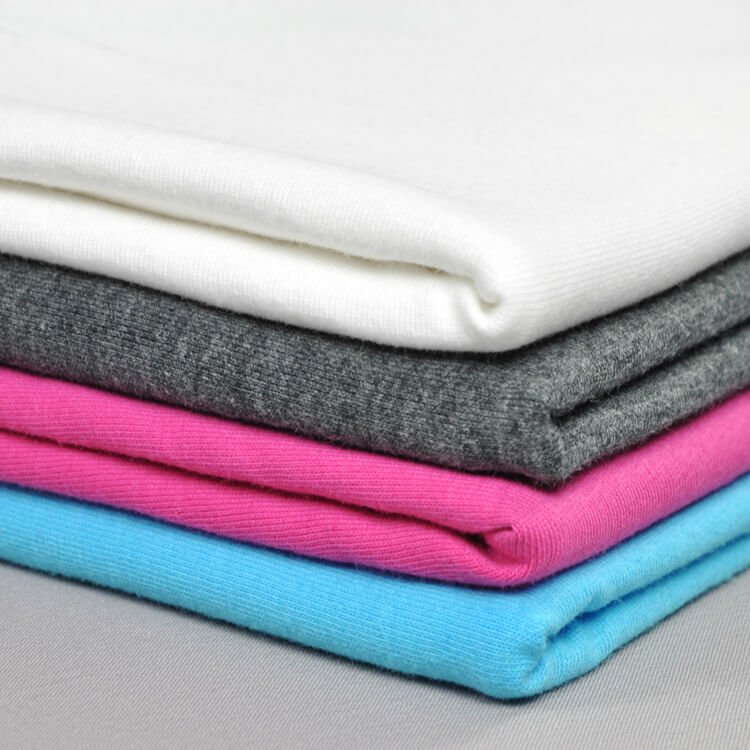
What to Look for When Buying
Quality Indicators
- Even knit structure: Hold fabric up to light. The loops should be consistent with no gaps or irregularities.
- Good recovery: Stretch it and release. It should quickly return to its original shape.
- Soft feel: Quality cotton jersey feels smooth, not rough or scratchy.
- Appropriate weight: The GSM should match your intended use.
- Colorfastness: Ask about dye quality to ensure colors won’t bleed or fade quickly.
- Pre-shrunk: Look for pre-shrunk or sanforized cotton jersey.
What is Another Name for Cotton Jersey?
Cotton jersey may also be called:
- Jersey knit cotton
- Single jersey cotton (for standard construction)
- T-shirt knit (informal term)
- Cotton interlock (specifically for double jersey)
Certifications to Look For
| Certification | What It Means | Why It Matters |
|---|---|---|
| GOTS (Global Organic Textile Standard) | Organic cotton grown without pesticides, processed with eco-friendly methods | Ensures environmental sustainability and no harmful chemicals |
| OEKO-TEX Standard 100 | Tested for harmful substances, safe for human use | Guarantees no toxic chemicals in the fabric |
| Fair Trade | Workers receive fair wages and work in safe conditions | Supports ethical production practices |
| BCI (Better Cotton Initiative) | Cotton grown with improved environmental and social practices | More sustainable than conventional cotton |
Price Ranges
Cotton jersey prices vary based on quality:
- Budget: $5-8 per yard (basic quality, may have inconsistencies)
- Mid-range: $8-15 per yard (good quality for most projects)
- Premium: $15-25 per yard (designer prints, organic, specialty cotton)
- Luxury: $25+ per yard (high-end fashion grade, unique fibers)
What is the Most Expensive Fabric?
While cotton jersey is affordable, the most expensive fabrics in the world include vicuña wool (up to $3,000 per yard), silk-cashmere blends, and specialty luxury textiles. Among cottons, Egyptian long-staple cotton and Sea Island cotton command premium prices, though even these are far more affordable than luxury animal fibers.
Frequently Asked Questions
Conclusion
Cotton jersey fabric has earned its place as a wardrobe staple for good reason. Its unique combination of softness, breathability, natural stretch, and ease of care makes it ideal for countless projects, from basic t-shirts to elegant dresses.
Throughout this guide, you’ve learned how cotton jersey differs from other fabrics, how to choose the right weight for your needs, and how to care for it properly. Whether you’re sewing your first t-shirt or selecting comfortable clothing for your family, understanding cotton jersey helps you make better decisions.
Key Takeaways
- Weight matters: Use 150-200 GSM for summer garments, 200-220 GSM for dresses and everyday wear, and 250+ GSM for hoodies and winter items.
- Always pre-wash: Wash and dry your cotton jersey before cutting to eliminate shrinkage (expect 2-5% for pre-shrunk, up to 20% for untreated fabric).
- Care properly: Wash in cold water and air dry or tumble dry on low heat to maintain quality and prevent excessive shrinkage.
- Consider blends wisely: Cotton-spandex blends (95/5) offer better stretch and recovery than 100% cotton while maintaining breathability.
- Use proper techniques: Ballpoint needles, stretch stitches, and gentle handling are essential for successful sewing projects.
- Check quality: Look for even knit structure, good recovery, and appropriate GSM for your intended use.
- Look for certifications: GOTS and OEKO-TEX certifications ensure your cotton jersey is free from harmful chemicals and sustainably produced.
Final Recommendations
If you’re just starting out: Begin with medium-weight cotton-spandex jersey (200 GSM, 95/5 blend) for your first projects. This weight is forgiving, easy to work with, and suitable for most clothing items. Practice on scraps before cutting into your main fabric.
For summer comfort: Stock up on lightweight pure cotton jersey (150-180 GSM) in versatile colors. The breathability and moisture-wicking properties make it unbeatable for hot weather.
For children and babies: Choose certified organic cotton jersey to avoid exposing sensitive skin to chemicals. Stick to medium-lightweight options (180-200 GSM) that are soft yet durable enough for active play and frequent washing.
For fitted clothing: Opt for cotton-spandex blends with at least 5% spandex content for better shape retention and stretch recovery.
For special occasions: Select premium ring-spun cotton jersey or cotton-modal blends for garments that require beautiful drape and luxurious feel.
Moving Forward
As textile technology advances, cotton jersey production continues to improve. Sustainable manufacturing methods, better organic farming practices, and innovative fiber blends enhance both performance and environmental impact. Whether you’re an experienced sewer or just starting out, cotton jersey remains a reliable, comfortable, and accessible fabric choice.
The next time you reach for that favorite t-shirt or slip into comfortable loungewear, you’ll appreciate the craftsmanship and science behind cotton jersey fabric. With this knowledge, you can make informed decisions about selecting, caring for, and creating with this remarkable textile.
Ready to start your next project? Explore our collection of beginner-friendly sewing patterns and discover what you can create with cotton jersey fabric.


